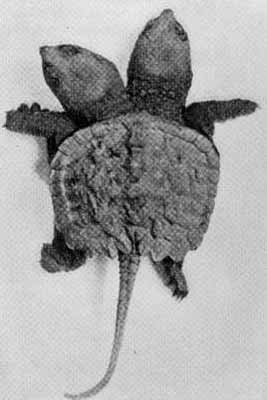Nip and Tuck
By S. M. CEDERSTROM
Nature Magazine, March 1932
Now the animal life of Minnesota can rank with the many-headed dragons in China and the tri-headed Hydras in Crete. Our unsung monstrosity is a two-headed turtle. It was found in the fall on the shore of Lake Minnetonka and was given to the Zoology Department, University of Minnesota. The turtle is an ordinary hardshell snapping turtle of the species Chelydra serpentine. It was at that time about the size of a fifty cent piece and save for the possession of two well-formed heads was similar to all other turtles of its size and kind. X-ray pictures taken of this turtle reveal that each neck has the usual number of vertebrae and that each lateral half of the animal has an independent digestive tract which joins the other near the posterior of the body.

IS IT AN "IT" OR A "THEY"?
Considerable difficulty was experienced at first in getting it (or them) to eat, so they (or it) were "farmed out" to the Museum of Natural History in the Minneapolis Public Library. The curator, Mrs. Grace Wiley, was raising several other turtles at the time, and with these companions "Nip and Tuck" (the newly christened two-headed little snapper) soon learned to take food. It feeds through either mouth, either alternately or, at times, coordinately. It appears as if the movements of each side of the body are regulated or controlled by the brain on that side of the body. This is especially evident when each head spies food and strives to get it at the same time.
This turtle has been kept in captivity for nearly a year and bids fair to grow up, since it is active, eats well and is steadily gaining in size and weight. The specimen is the property of the University of Minnesota but is kept most of the time in the Museum of Natural History in the Public Library where it has been seen and marveled at by thousands of visitors.
 Printer-friendly version
Printer-friendly version
